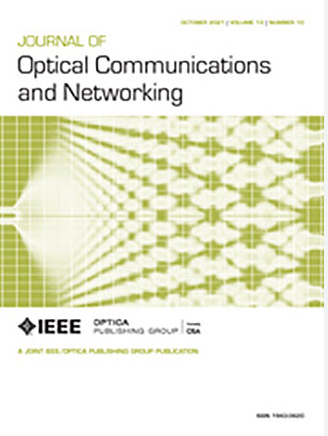Demonstration of an SDN-enabled, resilient, rate-adaptable hybrid fiber/outdoor FSO/mmWave transport for a 6G X-haul architecture
IF 4.3
2区 计算机科学
Q1 COMPUTER SCIENCE, HARDWARE & ARCHITECTURE
引用次数: 0
Abstract
The transition to 6G networks will necessitate advanced infrastructures to handle massive device integration, exponential data growth, and low latency requirements. The proposed 6G architecture will integrate diverse technologies, such as free space optical (FSO) and mmWave, into the existing fiber infrastructure. This work demonstrates a hybrid 6G X-haul solution consisting of 10 km fiber/100 m FSO/5 m mmWave that employs a software-defined network as an interface platform to improve network resilience and flexibility in 6G networks. For this purpose, real-time traffic management and dynamic link switching operate within 600 µs, interacting with the heterogeneous physical layers. This enables the system to adapt to changing conditions and failures, ensuring continuous and uninterrupted connectivity. Experimental results proved that this dynamic software-defined networking-based topology can manage high-capacity data rates of up to 60 Gbps while supporting adaptive modulation schemes below hard decision-forward error correction.为6G X-haul架构演示支持sdn、弹性、速率自适应的混合光纤/室外FSO/毫米波传输
向6G网络的过渡将需要先进的基础设施来处理大规模设备集成、指数级数据增长和低延迟需求。拟议的6G架构将把自由空间光(FSO)和毫米波等多种技术集成到现有的光纤基础设施中。这项工作展示了一种混合6G X-haul解决方案,该解决方案由10公里光纤/100米FSO/5米毫米波组成,采用软件定义网络作为接口平台,以提高6G网络的网络弹性和灵活性。为此,实时流量管理和动态链路交换在600µs内运行,与异构物理层相互作用。这使得系统能够适应不断变化的条件和故障,确保连续和不间断的连接。实验结果证明,这种基于动态软件定义网络的拓扑结构可以管理高达60 Gbps的大容量数据速率,同时支持低于硬决策前向纠错的自适应调制方案。
本文章由计算机程序翻译,如有差异,请以英文原文为准。
求助全文
约1分钟内获得全文
求助全文
来源期刊
CiteScore
9.40
自引率
16.00%
发文量
104
审稿时长
4 months
期刊介绍:
The scope of the Journal includes advances in the state-of-the-art of optical networking science, technology, and engineering. Both theoretical contributions (including new techniques, concepts, analyses, and economic studies) and practical contributions (including optical networking experiments, prototypes, and new applications) are encouraged. Subareas of interest include the architecture and design of optical networks, optical network survivability and security, software-defined optical networking, elastic optical networks, data and control plane advances, network management related innovation, and optical access networks. Enabling technologies and their applications are suitable topics only if the results are shown to directly impact optical networking beyond simple point-to-point networks.

 求助内容:
求助内容: 应助结果提醒方式:
应助结果提醒方式:


